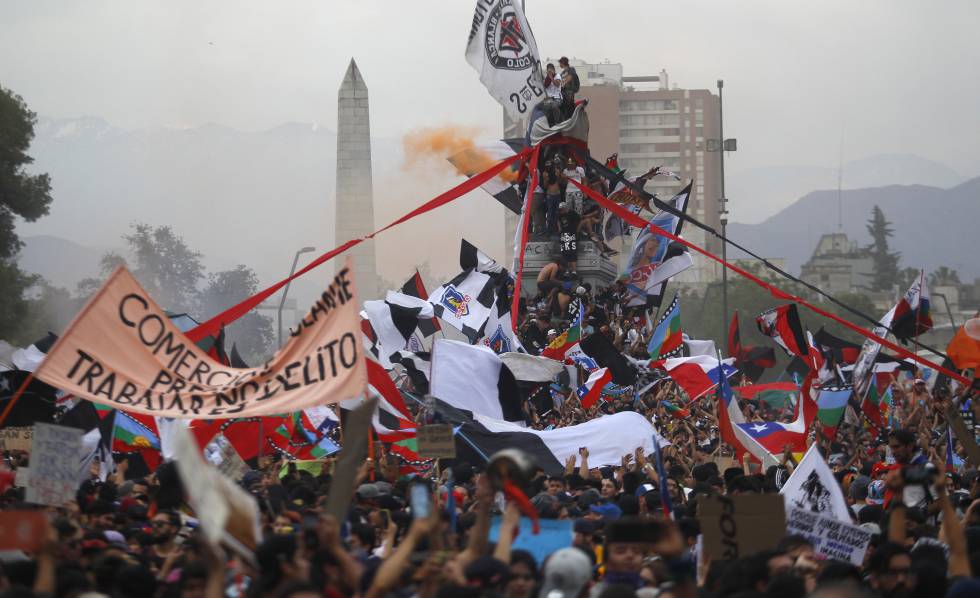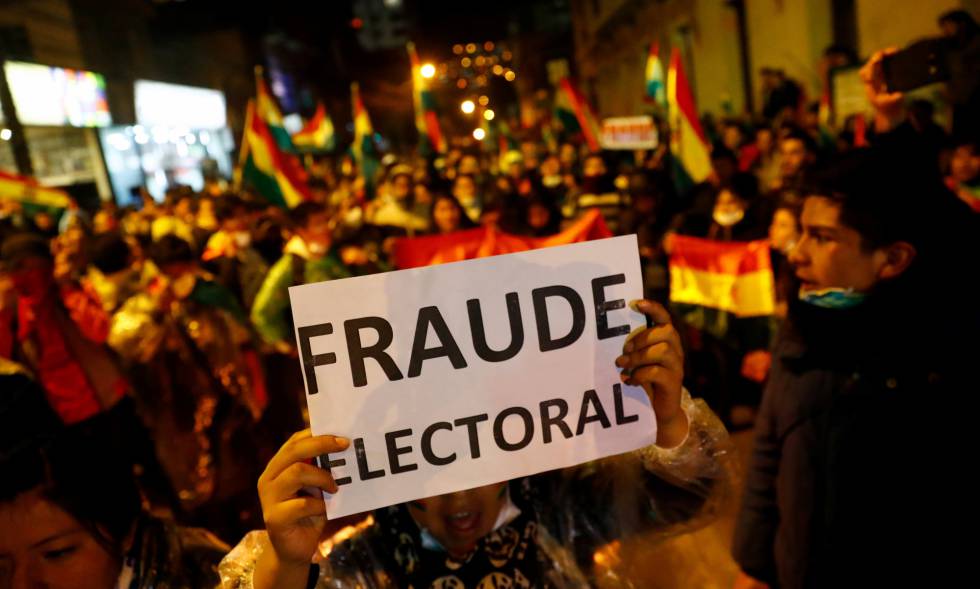
Frustrated expectations, disaffection with politicians
have dynamited the patience of millions of people and explain the protests that
happen from north to south in the region.
Frustrated
expectations have dynamited the patience of millions of Latin Americans. Protests
in the most unequal region of the planet are happening at a dizzying pace, from
Haiti to Chile; from Central America to the Andes. Finding a simple explanation
for a region with about twenty countries and more than 600 million people,
however, is chimerical, despite the efforts of not a few to try to build a sort
of Latin American spring - on a continent where, for more information. , the
stations shine by their absence - or put together a complex orchestrated by
Venezuela, which despite not standing, it does have the ability to destabilize
almost a whole continent. The
slowdown to millions of yearnings, the questioning of economic models such as
neoliberalism, the disaffection by politicians, regardless of their ideology,
is a common fuel in all countries to catch a flare that has no signs of going
out in the short term.
Latin
America is a hotbed of protests in a world that became a “cartography to
decipher”, in the words of journalist and historian Pablo Stefanoni. In
some cases because the quality of life worsens, as in Argentina or Ecuador;
also in Chile or, years ago, Brazil, where the expectations of a middle class
to which more and more people joined were also stopped. The mobilizations of
these countries, the least media of students in Colombia or those of Haiti, are
not understood either without turning to see the yellow yellow vests, the
protests of Hong Kong or, more recently, those of Lebanon. However, social
outbursts have been part of the Latin American political landscape for decades
and had a peak in the late nineties and early this century. “There is a whole culture of mobilization that
works as a pressure mechanism to demand the extension of rights and a decrease
in historical social injustices,” explains Luciana Cadahia, a researcher at
CALAS Andes.
Current
protests arise in a context of slowdown or economic crisis. Latin
America emerged virtually unscathed from the global crisis of 2008, but now it
is the most hit region. According to the forecasts of the International
Monetary Fund (IMF), the body that, on the other hand, is once again in the
center of sight of almost all protests, the region will grow by 0.2%, almost
nothing in practice. In less than a year the prediction dropped from 1.4% to
0.6% 90 days ago. In parallel, Asian economies are expected to have an average
growth of 5.9% and in Africa of 3.2%.
 Although
each country has its specific characteristics, the end of the boom in raw
materials or commodities overcomes economic uncertainty. “On some sides
what is exhausted is neoliberalism, on other national-popular projects there is
a fundamental problem that the region cannot face which is the development
model. Even on the left turn, the improvements were redistributive, social
policies that democratized consumption. There were no substantive changes, neither economic nor institutional”,
deepens Stefanoni. Although income inequality has been reduced since 2000, one
in 10 Latin Americans lives in extreme poverty (10.2%). In 2002 there
were 57 million people in extreme famine situation in Latin America; 15 years
later, the figure rose to 62 million. In 2008 it was 63 million, according to ECLAC. “One of the common
denominators is the frustrated expectations, the precariousness of the people
who had recovered something and now see how their desires and dreams fall
apart. That has exacerbated an enormous fury”, says Arturo Valenzuela, deputy
secretary of state for Latin America during the Administration of Barack Obama.
Although
each country has its specific characteristics, the end of the boom in raw
materials or commodities overcomes economic uncertainty. “On some sides
what is exhausted is neoliberalism, on other national-popular projects there is
a fundamental problem that the region cannot face which is the development
model. Even on the left turn, the improvements were redistributive, social
policies that democratized consumption. There were no substantive changes, neither economic nor institutional”,
deepens Stefanoni. Although income inequality has been reduced since 2000, one
in 10 Latin Americans lives in extreme poverty (10.2%). In 2002 there
were 57 million people in extreme famine situation in Latin America; 15 years
later, the figure rose to 62 million. In 2008 it was 63 million, according to ECLAC. “One of the common
denominators is the frustrated expectations, the precariousness of the people
who had recovered something and now see how their desires and dreams fall
apart. That has exacerbated an enormous fury”, says Arturo Valenzuela, deputy
secretary of state for Latin America during the Administration of Barack Obama.
“The
current popular protests are closely linked to the economic model that, since
the 1990s, is about implementing over and over again in the region”, considers Cadahia, who, like other analysts
consulted, sees the different types of adjustment of Governments, one of the
common denominators of the protests: “States have the role of protecting an
economic model that does not generate jobs or need to reduce inequality gaps. So
stop investing in key aspects such as education and technology. The institutions deteriorate, the
inequalities grow and the malaise begins to be felt by each citizen when he
discovers how his daily life is deteriorating, his day to day”. In that sense,
the Cuban academic and feminist Ailynn Torres considers that the protests “lash
out against the order of inequality, which the governments of the previous
progressive cycle did not deactivate in a remarkable way, and the poverty that
did reduce considerably in the previous cycle, but that was progressively expanded
again after 2008, and very rapidly after 2015”, says the FLACSO researcher.
The
authority of the political class has been evidenced in recent weeks, although
the demand for new leaderships has been manifesting for months, if not years.
The source of instability is total, as Stefanoni illustrates: “In Chile in the
last election, less than 50% of the qualified voted, in Bolivia half of the
country believes that in the elections there was fraud, in Ecuador the
successor of Correa took a turn significant in their alliances and ideological
speeches, in Brazil they voted with one of the favorites (Lula) imprisoned and
accused of corruption, in Peru all former presidents ended up in jail for the
Odebrecht case and one committed suicide”.
It is
not so much about interpreting, then, the discomfort in the left or right axis.
The last Latinobarometer was already pointing in this line. For 75%
there is a perception that it is governed for a few and that governments do not
defend the interests of the majority. According to the study, only 5% think that there is full democracy; 27%
that there are small problems; 45%, big
problems and 12% believe that what is today cannot be called democracy. Further,
the average of those who consider Latin America democratic is 5.4 on a scale of
1 to 10.
 Oliver
Stuenkel, Professor of International Relations at the Getulio Vargas Foundation
in Sao Paulo, feels that "the numbers tell a story and the economic and
political elites are happy with those numbers, but the experience of the people
is different." Stuenkel gives as an example the protests of Brazil, in
2013, very similar in origin to those of Chile a week ago. “What we live is a
consequence of a very unequal society, not only from the economic point of
view. You have to see where the elites move, who they relate to. And we must
include the intellectual elite, journalists, analysts, among which I include
myself, did not anticipate this. It is a sign that the financial, political and
intellectual elite of Latin America has not been able to monitor and understand
what is happening in society”.
Oliver
Stuenkel, Professor of International Relations at the Getulio Vargas Foundation
in Sao Paulo, feels that "the numbers tell a story and the economic and
political elites are happy with those numbers, but the experience of the people
is different." Stuenkel gives as an example the protests of Brazil, in
2013, very similar in origin to those of Chile a week ago. “What we live is a
consequence of a very unequal society, not only from the economic point of
view. You have to see where the elites move, who they relate to. And we must
include the intellectual elite, journalists, analysts, among which I include
myself, did not anticipate this. It is a sign that the financial, political and
intellectual elite of Latin America has not been able to monitor and understand
what is happening in society”.
The most
paradigmatic example of this remoteness - beyond the autocratic blindness of
Nicolás Maduro, who tends to deny the greatest for years - may have been given
by the president of Chile these days. Sebastián Piñera went from celebrating
the oasis in which, supposedly, his country was to see how a pressure cooker
exploded; to say that they were at war against an almighty enemy, he went on to
greet the demonstrations that precisely demand his resignation and to demand
that his ministers make their positions available. Ailynn Torres, in line with
other analysts and academics consulted, is cautious about what will come: “The
results are uncertain and may not be much clearer when the acute moment is
over. What is at stake is much more than that; the people know it, and the
governments too”.
SOURCE: EL PAIS
